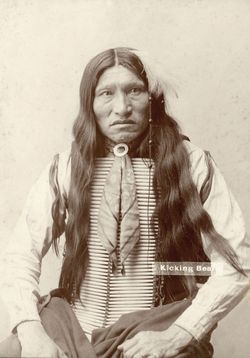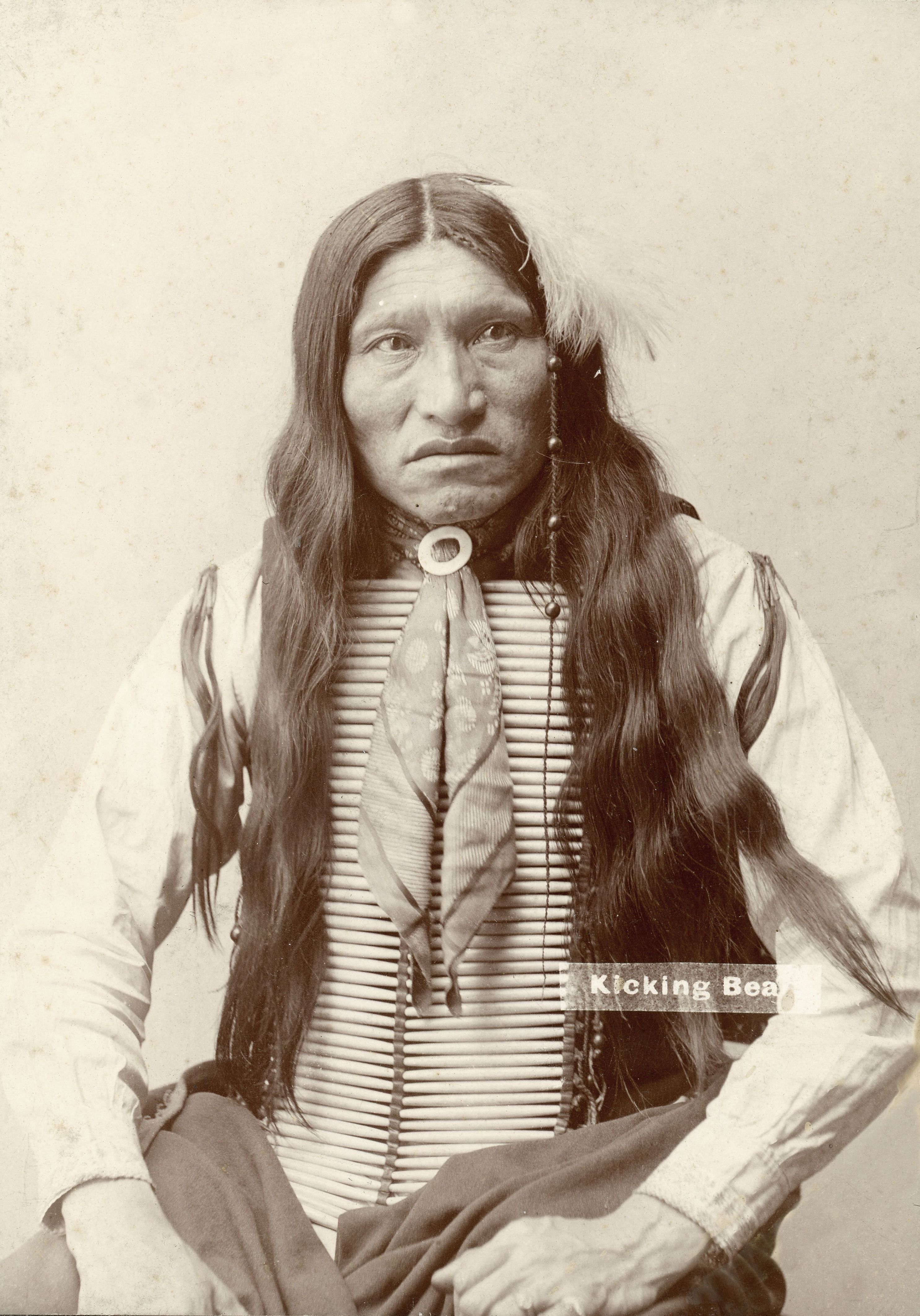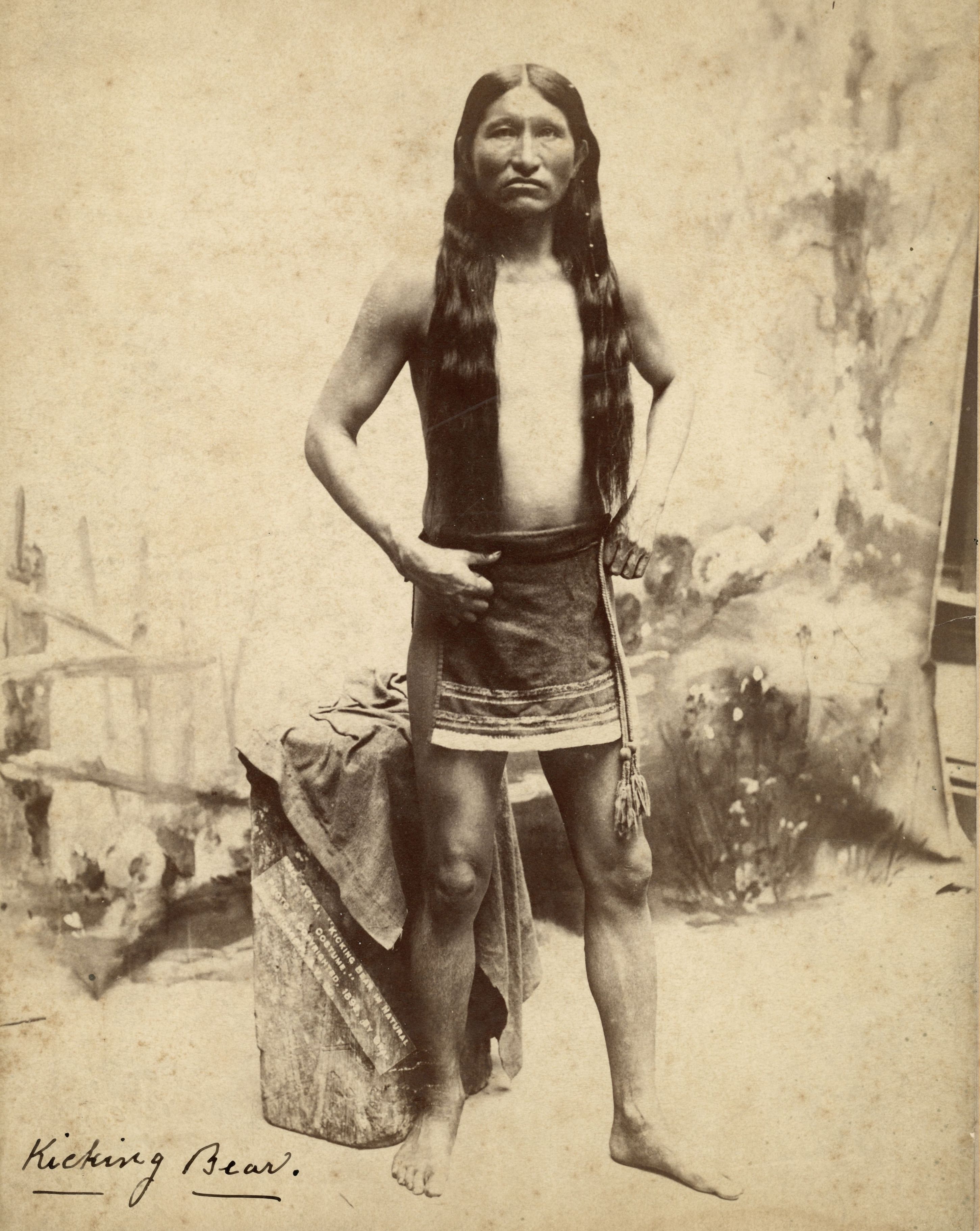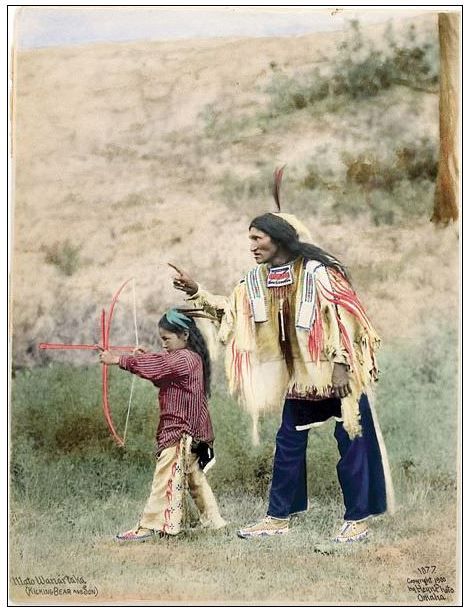Native American Leader, Painter. He received recognition as a Native American leader who was a Medicine Man, Ghost Dancer and painter. Born into the Oglala band of the Lakota or Teton Sioux, his wife, Woodpecker Woman, was a Cheyenne. He was highly respected within the Cheyenne Nation. He married into the Miniconjou band of the Lakota or Teton Sioux with his wife, Woodpecker Woman, a daughter of Spotted Elk, a.k.a. Big Foot of the Miniconjou Band. He became a Miniconjou band chief. His mothers' name was Iron Cedar Woman and his father's name was Black Fox. The Indian council appointed him along with his brother-in-law Short Bull to attend a religious ghost dance ceremony in Utah, held by Wovoka, a Piute Indian. After learning the ghost dance, Kicking Bear along with Short Bull, taught the ritual to the Sioux Nation. He delivered a persuasive speech to the Sioux Nation assuring and sealing their belief in the ghost dance ritual. This movement led indirectly to the Wounded Knee Massacre, the slaughter of approximately 150 to 300 Lakota Indians by the United States Army on December 29, 1890, halting any rebellious resistance to forced reservation life. After the Wounded Knee Massacre, he was arrested and sent to Fort Sheridan, Illinois and served a year in prison. After agreeing to join Buffalo Bill Cody's Wild West Show, his sentence was commuted. He toured with Cody's Wild West Show for a year in Europe. Humiliated, he returned to his family on the Pine Ridge Reservation. Kicking Bear fought honorably in the Black Hills Wars, specifically, in the Battle of the Little Big Horn along side his cousin Crazy Horse, Sitting Bull, and Rain In The Face, against Custer and his 7th Calvary. Twenty years later, he painted a scene of the battlefield. His 1898 watercolor on muslin painting, "The Battle of the Little Bighorn," has in the middle of the painting, chiefs Sitting Bull, Rain in the Face, Crazy Horse and Kicking Bear, and to the right of the red figure in the center is the defeated General Custer. The painting is exhibited at the Southwest Museum of the American Indian Collection in the Autry Museum in Los Angeles. After painting this depiction, Kicking Bear slowly faded away into the history of the old west, dying six years later.
Native American Leader, Painter. He received recognition as a Native American leader who was a Medicine Man, Ghost Dancer and painter. Born into the Oglala band of the Lakota or Teton Sioux, his wife, Woodpecker Woman, was a Cheyenne. He was highly respected within the Cheyenne Nation. He married into the Miniconjou band of the Lakota or Teton Sioux with his wife, Woodpecker Woman, a daughter of Spotted Elk, a.k.a. Big Foot of the Miniconjou Band. He became a Miniconjou band chief. His mothers' name was Iron Cedar Woman and his father's name was Black Fox. The Indian council appointed him along with his brother-in-law Short Bull to attend a religious ghost dance ceremony in Utah, held by Wovoka, a Piute Indian. After learning the ghost dance, Kicking Bear along with Short Bull, taught the ritual to the Sioux Nation. He delivered a persuasive speech to the Sioux Nation assuring and sealing their belief in the ghost dance ritual. This movement led indirectly to the Wounded Knee Massacre, the slaughter of approximately 150 to 300 Lakota Indians by the United States Army on December 29, 1890, halting any rebellious resistance to forced reservation life. After the Wounded Knee Massacre, he was arrested and sent to Fort Sheridan, Illinois and served a year in prison. After agreeing to join Buffalo Bill Cody's Wild West Show, his sentence was commuted. He toured with Cody's Wild West Show for a year in Europe. Humiliated, he returned to his family on the Pine Ridge Reservation. Kicking Bear fought honorably in the Black Hills Wars, specifically, in the Battle of the Little Big Horn along side his cousin Crazy Horse, Sitting Bull, and Rain In The Face, against Custer and his 7th Calvary. Twenty years later, he painted a scene of the battlefield. His 1898 watercolor on muslin painting, "The Battle of the Little Bighorn," has in the middle of the painting, chiefs Sitting Bull, Rain in the Face, Crazy Horse and Kicking Bear, and to the right of the red figure in the center is the defeated General Custer. The painting is exhibited at the Southwest Museum of the American Indian Collection in the Autry Museum in Los Angeles. After painting this depiction, Kicking Bear slowly faded away into the history of the old west, dying six years later.
Bio by: Bedford W. Sipes
Family Members
Advertisement
See more Kicking Bear memorials in:
Records on Ancestry
Sponsored by Ancestry
Advertisement







